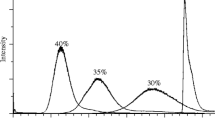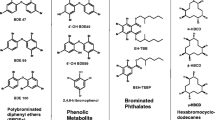Abstract
Assessment of xenoestrogenic activity in human serum samples requires the removal of endogenous sex hormones to assure that the activity measured originates from xenobiotic compounds only. Serum samples representing high, medium and lower accumulation of persistent organic pollutants (POPs) were extracted using solid-phase extraction (SPE) followed by normal-phase high-performance liquid chromatography (NP-HPLC) for separation of POPs from endogenous hormones. The recovery of polychlorinated biphenyl (PCB) congeners in spiked serum samples was up to 86 %, making the extraction method suitable for the study. MVLN cells, stably transfected with an estrogen receptor (ER) luciferase reporter vector (estrogen response element chemically activated luciferase expression, ERE-CALUX), were exposed to the reconstituted SPE-HPLC extracts for determination of the integrated estrogenic activity. The effects of PCBs were analyzed by direct in vitro exposure of PCBs (nos. 138, 153, 180) and by ex vivo analysis of SPE-HPLC extracts from serum spiked with the PCBs. Similar effects on ER transactivation were observed for the direct in vitro and the ex vivo analysis experiments. The ER transactivation responses determined for actual serum samples were in the linear range of the dose-response curve. 17β-Estradiol titrations showed that the xenoestrogenic effects were mediated via ER. Moreover, our SPE-HPLC-ERE-CALUX assay was demonstrated to elicit high interlaboratory correlation. In the present study the combination of SPE-HPLC purification and the ex vivo estrogenic responses measured by ERE-CALUX was validated and considered to be a valuable tool to assess the combined ER effect of lipophilic serum POPs where additive/synergistic and agonistic/antagonistic effects are integrated giving an overall estimate of exposure and bioactivity.









Similar content being viewed by others
Abbreviations
- BPA:
-
Bisphenol A
- BPA-DM:
-
Bisphenol A dimethacrylate
- CALUX:
-
Chemically activated luciferase expression
- CV:
-
Coefficient of variation
- DC-FCS:
-
Dextran-treated fetal calf serum
- DDE:
-
Dichlorodiphenyl dichloroethylene
- DDT:
-
Dichlorodiphenyl trichloroethane
- DMEM:
-
Dulbecco’s modified Eagle’s medium
- DMSO:
-
Dimethyl sulfoxide
- E1:
-
Estrone
- E2:
-
17β-Estradiol
- EC40 :
-
Concentration exerting 40 % of the effect of the maximal effective concentration
- ER:
-
Estrogen receptor
- ERE:
-
Estrogen response element
- GC:
-
Gas chromatography
- HPLC:
-
High-performance liquid chromatography
- KHF:
-
Female serum control
- KHM:
-
Male serum control
- logK ow :
-
Logarithm of the octanol–water partitioning coefficient
- LTH:
-
Laboratoire de la Toxicologie Humaine
- MS:
-
Mass spectrometry
- NP:
-
4n-Nonylphenol
- PCB:
-
Polychlorinated biphenyl
- POP:
-
Persistent organic pollutant
- SPE:
-
Solid-phase extraction
- t R :
-
Retention time
- ɛ o :
-
Eluotropic strength
References
Lindstrom G, Hooper K, Petreas M, Stephens R, Gilman A (1995) Environ Health Perspect 103(Suppl 2):135–142
Steenland K, Bertazzi P, Baccarelli A, Kogevinas M (2004) Environ Health Perspect 112(13):1265–1268
Weisglas-Kuperus N (1998) Chemosphere 37(9–12):1845–1853
Bonefeld Jorgensen EC, Ayotte P (2003) AMAP assessment 2002: human health in the Arctic. AMAP, Oslo, pp 57–74
Toft G, Hagmar L, Giwercman A, Bonde JP (2004) Reprod Toxicol 19(1):5–26
Charlier CJ, Albert AI, Zhang L, Dubois NG, Plomteux GJ (2004) Clin Chim Acta 347(1–2):177–181
Rignell-Hydbom A, Rylander L, Giwercman A, Jonsson BA, Lindh C, Eleuteri P, Rescia M, Leter G, Cordelli E, Spano M, Hagmar L (2005) Environ Health Perspect 113(2):175–179
Ibarluzea Jm J, Fernández MF, Santa-Marina L, Olea-Serrano MF, Rivas AM, Aurrekoetxea JJ, Exposito J, Lorenzo M, Torne P, Villalobos M, Pedraza V, Sasco AJ, Olea N (2004) Cancer Causes Control 15(6):591–600
Brown JF Jr, Lawton RW, Morgan CB (1994) Chemosphere 29(9–11):2287–2294
Phillips DL, Smith AB, Burse VW, Steele GK, Needham LL, Hannon WH (1989) Arch Environ Health 44(6):351–354
Hunter DJ, Hankinson SE, Laden F, Colditz GA, Manson JE, Willett WC, Speizer FE, Wolff MS (1997) N Engl J Med 337(18):1253–1258
Longnecker MP, Ryan JJ, Gladen BC, Schecter AJ (2000) Arch Environ Health 55(3):195–200
Smith D (1999) Int J Epidemiol 28(2):179–188
Bonefeld-Jorgensen EC (2004) Sci Total Environ 331(1–3):215–231
Safe S (1990) Crit Rev Toxicol 21(1):51–88
Bonefeld-Jorgensen EC, Andersen HR, Rasmussen TH, Vinggaard AM (2001) Toxicology 158(3):141–153
Grunfeld HT, Bonefeld-Jorgensen EC (2004) Toxicol Lett 151(3):467–480
Soto AM, Chung KL, Sonnenschein C (1994) Environ Health Perspect 102(4):380–383
Dees C, Askari M, Foster JS, Ahamed S, Wimalasena J (1997) Mol Carcinog 18(2):107–114
Mussalo-Rauhamaa H (1991) Sci Total Environ 103(2–3):159–175
Rusiecki JA, Matthews A, Sturgeon S, Sinha R, Pellizzari E, Zheng TZ, Barisi D (2005) Cancer Epidemiol Biomarkers Prev 14(5):1113–1124
Patterson JDG, Furst P, Henderson LO, Isaacs SG, Alexander LR, Turner WE, Needham LL, Hannon H (1989) Chemosphere 19(1–6):135
Rasmussen TH, Nielsen F, Andersen HR, Nielsen JB, Weihe P, Grandjean P (2003) Environ Health 2(1):12
Rivas A, Fernández MF, Cerrillo I, Ibarluzea J, Olea-Serrano MF, Pedraza V, Olea N (2001) APMIS 109(3):185–197
Fernández MF, Rivas A, Olea-Serrano F, Cerrillo I, Molina-Molina JM, Araque P, Martinez-Vidal JL, Olea N (2004) Anal Bioanal Chem 379(1):163–170, Epub 2004 Mar 2013
Sonnenschein C, Soto AM, Fernández MF, Olea N, Olea-Serrano MF, Ruiz-López MD (1995) Clin Chem 41(12 Pt 2):1888–1895
Andersen HR, Vinggaard AM, Rasmussen TH, Gjermandsen IM, Bonefeld-Jorgensen EC (2002) Toxicol Appl Pharmacol 179 (1):1–12
Bonefeld-Jorgensen EC, Hjelmborg PS, Reinert LS, Andersen BS, Lindh CH, Hagmar L, Giwercman A, Erlandsen M, Manicardi G-C, Spano M, Toft G, Bonde JP (2006) Environ Health 5(1):12 [Epub ahead of print]
Pons M, Gagne D, Nicolas JC, Mehtali M (1990) Biotechniques 9(4):450–459
Villeneuve DL, Khim JS, Kannan K, Giesy JP (2002) Environ Toxicol 17(2):128–137
Demirpence E, Duchesne MJ, Badia E, Gagne D, Pons M (1993) J Steroid Biochem Mol Biol 46(3):355–364
Deutch B, Hansen JC (2000) Dan Med Bull 47(2):132–137
Bonefeld-Jorgensen EC, Grünfeld HT, Gjermandsen IM (2005) Mol Cell Endocrinol 244(1–2):20–30
Sadek PC (1996) (ed) The HPLC solvent guide. Wiley, Chichester
Pliskova M, Vondracek J, Canton RF, Nera J, Kocan A, Petrik J, Trnovec T, Sanderson T, van den Berg M, Machala M (2005) Environ Health Perspect 113(10):1277–1284
Gutendorf B, Westendorf J (2001) Toxicology 166(1–2):79–89
Quantitative Structure-Activity Relationships (QSAR) and Pesticides. http://www.mst.dk/udgiv/publications/2004/87-7614-434-8/html/bred03_eng.htm. Cited 18 Nov 2005
ChemIDplus. http://www.chem.sis.nlm.nih.gov/chemidplus/. Cited 18 Nov 2005
Robertson LW, Hansen LG (2001) (eds) PCBs: recent advances in environmental toxicology and health effects. The University Press of Kentucky, Lexington
4-Octylphenol (PDF file). http://www.nies.go.jp/edc/edcdb/HomePage_e/medb/chem/chempdf/chem7-2.pdf. Cited 18 Nov 2005
Acknowledgements
We thank our colleagues from the Unit of Cellular and Molecular Toxicology: Manhai Long and Tanja Krüger for scientific support, and Anne Keblovszki and Birgitte Sloth Andersen for excellent technical assistance. The study was supported by grants from the European Commission: INUENDO (http://www.inuendo.dk), grant no. QLK4-CT-2001-00202) and the Board of Danish Environmental Protection Agency.
Author information
Authors and Affiliations
Corresponding author
Rights and permissions
About this article
Cite this article
Hjelmborg, P.S., Ghisari, M. & Bonefeld-Jorgensen, E.C. SPE-HPLC purification of endocrine-disrupting compounds from human serum for assessment of xenoestrogenic activity. Anal Bioanal Chem 385, 875–887 (2006). https://doi.org/10.1007/s00216-006-0463-9
Received:
Revised:
Accepted:
Published:
Issue Date:
DOI: https://doi.org/10.1007/s00216-006-0463-9




